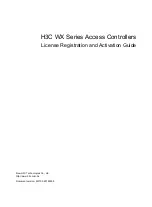
microHAM © 2010 All rights reserved
Invert: Some transceivers lack the ability to set the sense of the FSK input. If you cannot set the proper
sense, check the invert box. This is normally necessary only with the TenTec Omni V, Omni VI and
Kenwood TS-940.
Strict bps: Some programs rely on the the UART "buffer full" signal for proper PTT timing and drop PTT
(unkey) when the UART buffer is empty. Because virtual ports generally have two buffers - one in the USB
driver and one in the hardware - the first buffer may empty before all of the data has been transmitted
allowing the PTT to before the message is complete. 'Strict bps' disables the USB buffering and sends one
character at a time to the FSK output. With "Strict BPS" selected, the output will be about 20% slower due
to the presence of extra stop bits between characters but proper PTT operation will be assured.
NOTE: DO NOT select strict bps for MMTTY, USB option C provides accurate timing.
To test FSK operation from the computer to the radio, click the Test button with no port selected or the port
closed. The Test button will generate "RY" two times.
NOTE: Select RADIO1 or RADIO2 (as needed) with the TX R1/R2 button on micro2R when testing.
CW PORT
By its very nature, USB is not well suited to transfer the real time events required for CW keying. In
addition to the latency inherent in the USB protocols, there are also latencies caused by computer CPU
load, internal Windows message processing (inter-process communication) and data flow from another
peripherals sharing same the USB hub. This can result in transmitted characters that are garbled. To
minimize these unwanted operating system effects Router uses a specially developed oversampling and
prediction algorithm to assure the smoothest possible transfer of control signal events over USB. Using this
principle, CW keying in the Router is, in most cases, usable up to 50 WPM if the application generates
keying signals accurately and does not consume 100% of CPU time at the highest priority class.
Router allows assigning a virtual serial port for software CW using DTR or RTS signals. DTR* and RTS*
are identical to DTR/RTS except that the output is inhibited for one second after the COM port is opened.
RTS*/DTR* should only be used with programs that cause unwanted key-ups during startup.
NOTE: the CAT port may be used for CW if is provided by a microHAM interface.
TIP: More applications use DTR for CW than RTS.
When an application opens the COM port (usually at start-up), Router will indicate the channel is open.
The state of the CW channel is indicated by a red
arrow. If port is opened, it does not mean that it is
properly configured. The red arrow will light in time with
the transmitted CW when the port is properly
configured.
To test CW operation, click on the Test button with no port selected or the port closed.
NOTE: Select RADIO1 or RADIO2 (as needed) with the TX R1/R2 button on micro2R when testing.
22
















































